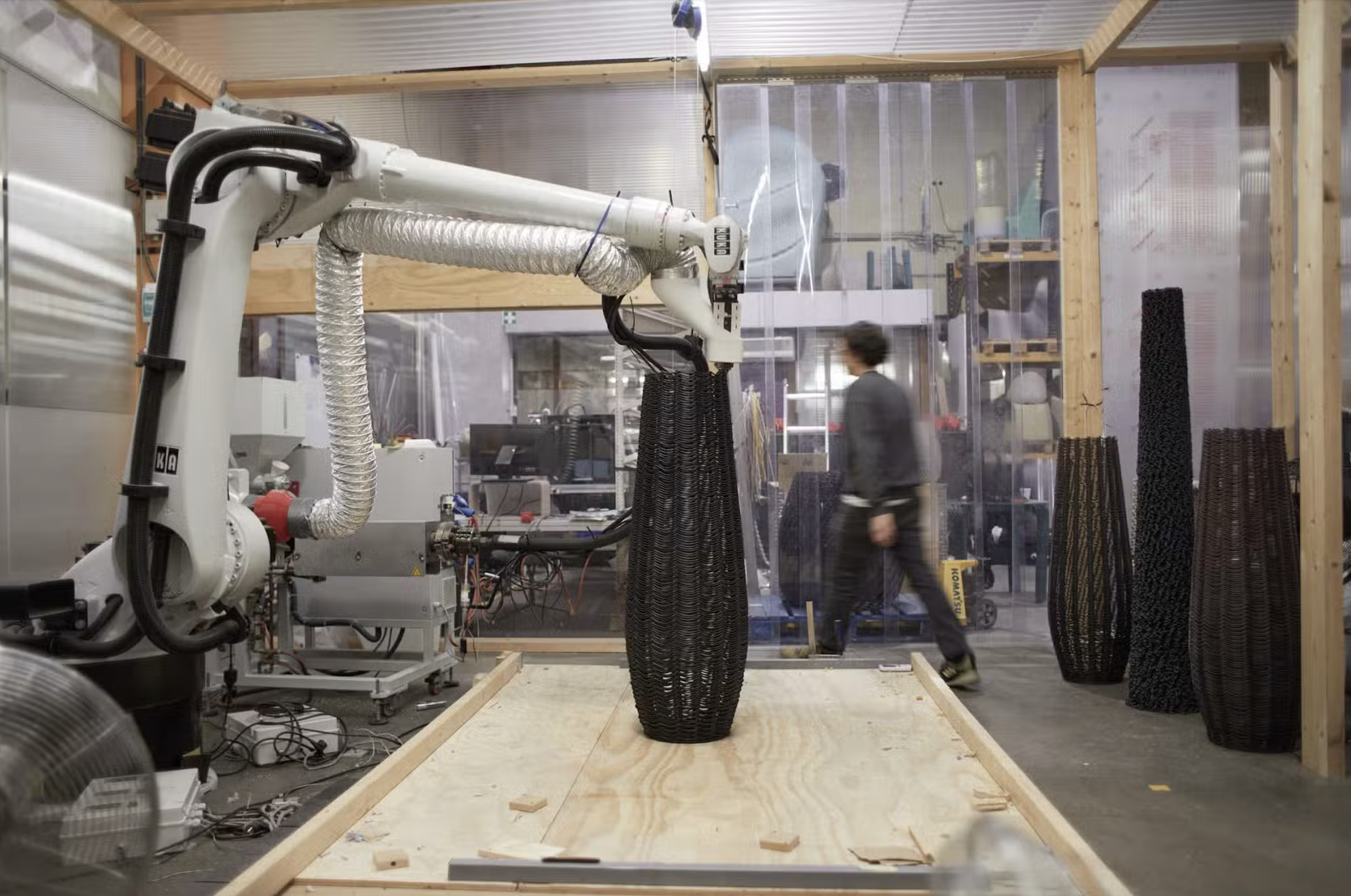The New Raw: Bridging Tradition and Innovation while Crafting a Greener Future
THE NEW RAW
At the crossroads of tradition and cutting-edge innovation stands The New Raw, a pioneering design studio committed to transforming plastic waste into stunning, sustainable creations. Their collaboration with acclaimed British designer Gareth Neal brings fresh energy to the dialogue between craftsmanship and technology, producing works that challenge the boundaries of materiality, aesthetics, and environmental responsibility. Founded by architects Panos Sakkas and Foteini Setaki, the studio transforms plastic waste into contemporary furniture and urban installations, using robots.
The New Raw Founders Panos Sakkas and Foteini Setaki.
In an age where environmental consciousness is more important than ever, the convergence of digital technology and traditional craftsmanship is emerging as a powerful force in shaping a sustainable future. As we face the challenges of climate change and resource depletion, the innovation at the intersection of these two worlds offers a beacon of hope. From the use of eco-friendly materials to the implementation of efficient production processes, this synergy is rewriting the narrative of craftsmanship and paving the way for a more sustainable planet.
The 3D-printing style is based on traditional crafts, utilising open weave structures. Photography by James Champion.
Introducing Digitally Woven: A Pioneering Collaboration
One of the most striking examples of this innovative fusion is Digitally Woven—an exquisite collaboration that brings together the best of both worlds. This project is the brainchild of British designer Gareth Neal, renowned for his ability to seamlessly integrate heritage craft into contemporary furniture design, and The New Raw, a forward-thinking studio that specialises in robotic manufacturing with plastic waste. Together, they have crafted a collection of objects that are not only aesthetically captivating but also environmentally responsible.
Revolutionary 3D Printing with Recycled Materials
At the heart of Digitally Woven lies a groundbreaking 3D-printing method that challenges traditional approaches. Instead of printing in layers, this method prints in loops, providing exceptional strength and resilience. But what truly sets this collection apart is the material used: thrice-recycled plastic. By choosing a material that has already been through the recycling process multiple times, the project champions sustainability, reducing the need for virgin resources and minimizing waste.
The resulting creations are far from the rigid, uniform objects typically associated with 3D printing. Instead, they boast a playful, organic aesthetic that is reminiscent of traditional craft techniques such as willow work, knitting, crocheting, and paper-cord weaving. These objects evoke the familiar, tactile qualities of handmade items while embodying the precision and innovation of digital technology.
A Canvas of Craftsmanship and Technology
Upon first sight, the Digitally Woven collection invites viewers into a world where the boundaries between the old and the new blur. The objects, with their intricate, looped structures, resemble icing from a piping bag—delicate yet robust. This visual connection to traditional crafts serves as a reminder of the deep-rooted techniques that have shaped human creativity for centuries. The exhibition stands as a testament to how these timeless practices can inform and inspire the latest advancements in digital manufacturing.
By bridging the gap between heritage craftsmanship and cutting-edge technology, Digitally Woven offers more than just a collection of beautifully designed objects. It provides a glimpse into the future of sustainable design, where the lessons of the past are combined with the tools of the present to create a more responsible and thoughtful approach to production.
Neal and The New Raw's technique is visibly different from typical 3D printing, where the filament is added in layers to build an object. Photography by James Champion.
The Loopy Chair from the Digitally Woven Exhibition. Photography by James Champion.
Shaping a Sustainable Future
As we move forward in our quest for sustainability, projects like Digitally Woven demonstrate the immense potential that lies in the collaboration between traditional and digital craftsmanship. By embracing both the old and the new, we can create solutions that are not only innovative but also deeply rooted in the values of sustainability and environmental stewardship.
This convergence of craftsmanship and technology challenges us to rethink how we approach design and production. It encourages us to look to the past for inspiration while using the tools of the future to build a more sustainable world. In doing so, we can ensure that the art of making remains a vibrant and vital part of our culture, one that contributes to the well-being of our planet for generations to come.
Discover More in Studio Atlas
Explore similar stories of innovative design and sustainable craftsmanship in our Studio Atlas section. From traditional weaving to the latest in 3D-printed furniture, we celebrate studios and practices around the world that push the boundaries of materiality and inspire a more thoughtful future for design.




